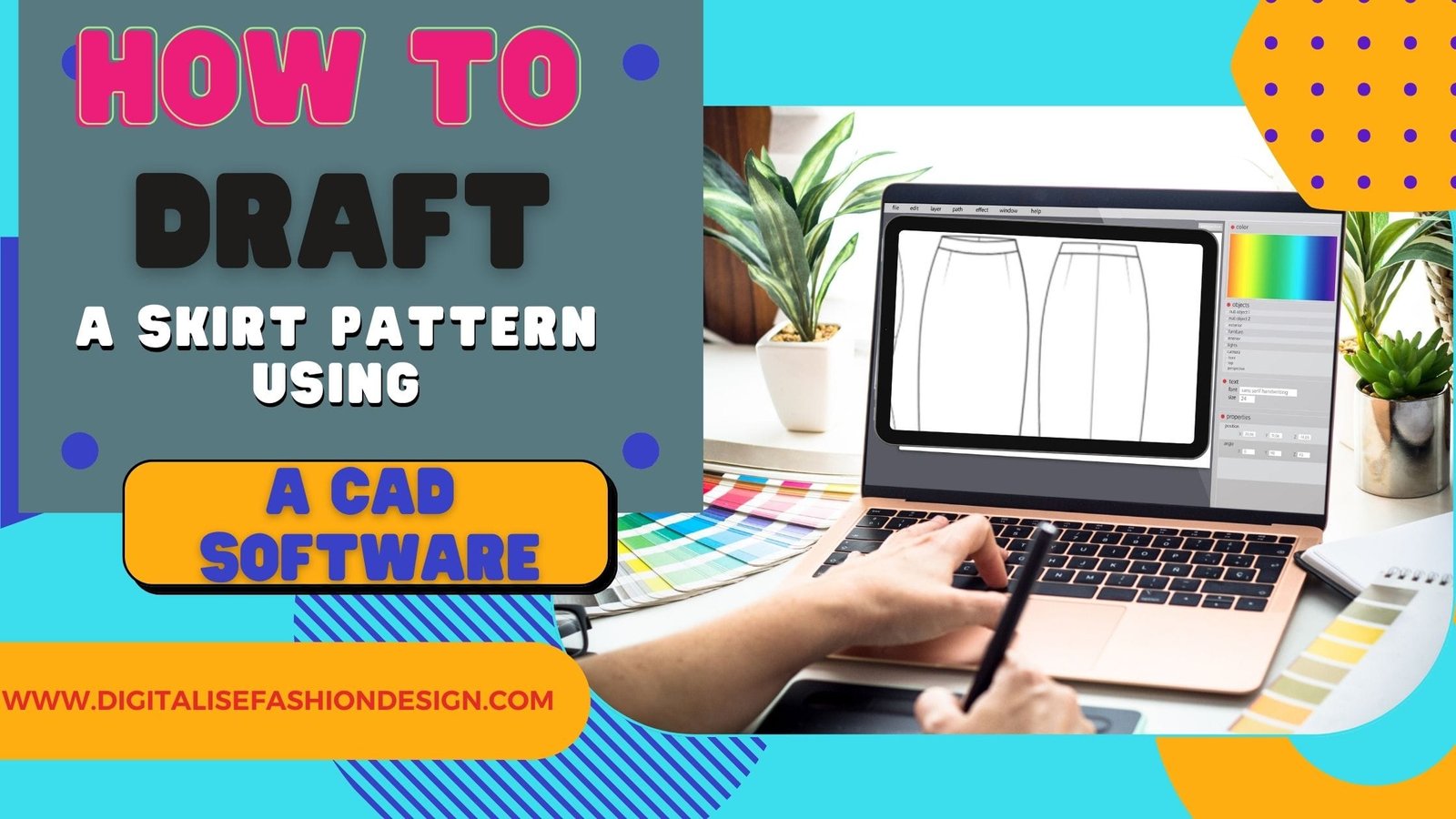Step-by-Step Guide: How to draft a Skirt Pattern with CAD Tools

Introduction to CAD Dress Pattern Making
Have you ever wondered how professional fashion designers create those perfectly fitted garments?
The secret lies in the art of pattern making, and in today’s digital age, Computer-Aided Design (CAD) has transformed this process.
In this comprehensive guide, we’ll enter into the world of CAD dress pattern software and show you how to draft skirt patterns like a pro.
Understanding CAD Software for Fashion Design
Before we jump into the nitty-gritty of pattern making, let’s take a moment to understand what CAD fashion design software is all about.
CAD tools have become indispensable in the fashion industry, offering precision, efficiency, and flexibility that traditional methods simply can’t match.
Popular CAD Pattern Making Tools
LEARN HERE HOW TO USE AUDACES CAD PATTERN DRAFTING TOOLS
There’s a wide array of CAD pattern making software available, ranging from professional-grade options to free alternatives for beginners. Some popular choices include:
- CLO3D
- Marvelous Designer
- Optitex
- Gerber AccuMark
- Lectra Modaris
- Audaces patterns
- seamly2D
- Valentino
- White rabbit CAD
- Browzwear
Each of these tools offers unique features, but they all serve the same purpose: to streamline the pattern making process and bring your fashion designs to life.
Benefits of Using CAD for Dress Patterns
OTHER INTERESTING BLOG POST
Why should you consider using CAD dress pattern software? Here are a few compelling reasons:
- Precision: CAD tools allow for exact measurements and adjustments.
- Time-saving: Repetitive tasks can be automated, speeding up the design process.
- Easy modifications: Changes can be made quickly without starting from scratch.
- Digital storage: Patterns can be saved, shared, and retrieved easily.
- 3D visualization: Many CAD tools offer 3D rendering capabilities.
Getting Started with how to draft a skirt pattern with CAD tools
WATCH THIS STEP BY STEP VIDEO ON HOW TO DRAFT A BASIC SKIRT BLOCK USING PATTERN MAKER PRO CAD
Now that we’ve covered the basics, let’s roll up our sleeves and get started with how to draft a skirt pattern with CAD tools
Setting Up Your Workspace
First things first, you’ll need to set up your digital workspace. This involves:
- Choosing your preferred CAD software
- Familiarizing yourself with the interface
- Learnig how to enter your measurements in the CAD tool
- Setting up your grid and measurement units
- Entering your measurements
- Creating a new project file
Basic Tools and Functions
Before starting your skirt pattern with CAD , it’s crucial to understand the basic tools and functions of your chosen CAD software. These typically include:
- Learning how the drawing tools work (line, curve, circle, etc.)
- Unstanding where to find the tools on the software
- Understanding how to imput the Measurements using the CAD tools
- Cutting and joining tools
- Dart and pleat creation tools
- Grading tools
- How to create PDF versions of your Skirt pattern with CAD
- How to download and print your finished pattern
Take some time to explore these features and practice using them. Remember, the more comfortable you are with your tools, the smoother your pattern making process will be.
Step-by-Step Guide to Drafting a Skirt Pattern with CAD
Now, let’s get to the heart of the matter: drafting a skirt pattern with CAD tools.
Taking Measurements
The first step in drafting a skirt pattern with CAD is taking accurate measurements. For a basic skirt, you’ll need:
- frontand back Waist measurement
- front and back Hip measurement
- Skirt length
- Distance from waist to hips
- Knee Circumference
HERE IS A FREE PATTERN DRAFTING MEASUREMENT SHEET YOU CAN USE
Input these measurements into your CAD software. Most programs have a dedicated section for storing and managing measurements.
Creating the Basic block Skirt pattern with Cad
With your measurements in place, it’s time to create the basic skirt pattern with CAD:
- Start by drawing a rectangle using your hip measurement for width and skirt length for height.
- Mark the waistline based on your waist circumference measurement.
- Mark your hipline according to your measurement
- Input your hip measurment.
- Note that when creating your skirt pattern with CAD tools, you are going to be usinf half of your measurements
- Use the CAD software’s curve tool to create the hip curve, ensuring it matches your waist measurement.
- Add darts to shape the waist. The exact placement and size will depend on the difference between your waist and hip measurements.
Modifying the Pattern for Different Styles
Once you have your basic block, the fun begins! You can modify this pattern to create various skirt styles:
- A-line skirt: Extend the side seams outward from the hip line.
- Pencil skirt: Taper the side seams slightly inward from the hip line.
- Pleated skirt: Use the pleat tool to add pleats at the waistline.
- Circle skirt: This requires a different approach, using the circle tool to create a donut shape.
Adding Seam Allowances and Notches to your Skirt pattern with CAD tools
Don’t forget to add seam allowances to your pattern pieces. Most CAD software has a dedicated tool for this. Also, add notches to mark important points like the center front, center back, and side seams.also remember to add letters to points on your skirt pattern .
This is particularly usefull if you want to create other skirt styles from your basic skirt pattern with CAD tools
Advanced Skirt pattern with CAD Pattern Making Techniques
As you become more comfortable with basic pattern making, you can explore advanced techniques to take your designs to the next level.
Pattern Grading in CAD
Pattern grading is the process of scaling a pattern to different sizes. CAD tools make this process much easier:
- Set up your size chart in the software.
- Use the grading tool to specify how each point of the pattern should move for different sizes.
- The software will automatically generate patterns for each size.
Creating Darts and Pleats
Darts and pleats add shape and structure to your skirt garments. Most CAD software offers specialized tools for creating these:
- Use the dart tool to add shaping to your skirt patterns.with CAD dart tools
- Experiment with different dart placements for various effects.
- Use the pleat tool to add volume and interest to skirts and dresses.
3D Visualization of Dress Patterns
One of the most exciting features of modern CAD pattern making software is 3D visualization:
- Apply virtual fabric to your pattern pieces.
- “Sew” the garment together in the software.
- View the finished garment on a virtual model.
- Make adjustments based on how the garment looks in 3D.
Tips for Professional CAD Pattern Making
To improve your CAD pattern making skills to a professional level, consider these tips:
Organizing Your Digital Pattern Library
Keep your digital patterns organized:
- Use a consistent naming convention for your files.
- Create folders for different garment types or collections.
- Regularly back up your pattern library.
Collaborating with Other Designers
Many CAD tools offer collaboration features:
- Share your patterns with team members.
- Use version control to track changes.
- Leave comments and feedback directly on the digital patterns.
Learning Resources for CAD Pattern Making
The world of CAD pattern making is vast, and there’s always more to learn. Here are some resources to help you continue your education:
Online Courses and Tutorials
- Coursera and Udemy offer courses on CAD pattern making.
- YouTube is a treasure trove of free tutorials.
- Many CAD software companies provide their own learning resources.
CAD Pattern Making Certification Programs
For those looking to pursue a career in fashion design, consider:
- Fashion Institute of Technology’s Digital Pattern Making Certificate
- London College of Fashion’s Digital Pattern Cutting Short Course
- Parsons School of Design’s Fashion Design and Digital Production Certificate
- University of fashion(online certification courses in pattern drafting)
The Future of CAD in Fashion Design
As technology continues to evolve, so does the world of CAD pattern making. Keep an eye out for emerging trends like:
- AI-assisted pattern making
- Virtual reality fitting rooms
- 3D printing of patterns and prototypes
Conclusion
Mastering CAD dress pattern software opens up a world of possibilities in fashion design.
From creating basic skirt patterns with CAD tools to exploring advanced techniques like 3D visualization, CAD tools empower designers to bring their visions to life with precision and efficiency.
Remember, like any skill, proficiency in CAD pattern making comes with practice. So, fire up your software, start experimenting, and watch your digital designs transform into beautiful, wearable garments.
FAQs
- What’s the best CAD pattern making software for beginners?
For beginners, user-friendly options like Audaces patterns , CLO3D or Marvelous Designer are great starting points. They offer intuitive interfaces and plenty of learning resources. - Can I use CAD pattern making software on a Mac?
Yes, many CAD pattern making software options are available for Mac, including CLO3D and Marvelous Designer. However, some programs may be Windows-only, so always check system requirements. - How long does it take to become proficient in CAD pattern making?
The learning curve varies, but with regular practice, you can become comfortable with basic functions in a few weeks to a few months. Mastering advanced techniques may take several months to a year. - Is it necessary to know traditional pattern making before learning CAD?
While not strictly necessary, understanding traditional pattern making principles can give you a solid foundation for CAD pattern making. However, many designers successfully learn both simultaneously. - Can CAD pattern making software generate sewing instructions?
Some advanced CAD software can generate basic sewing instructions, but typically, creating detailed sewing guides is still a manual process. The software primarily focuses on pattern creation and visualization.








